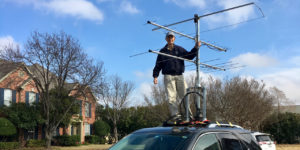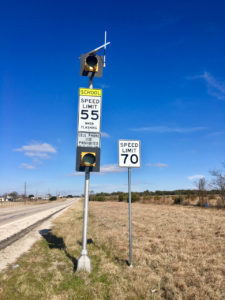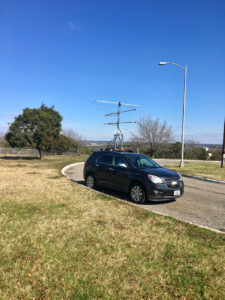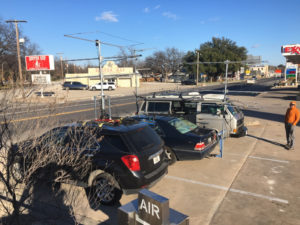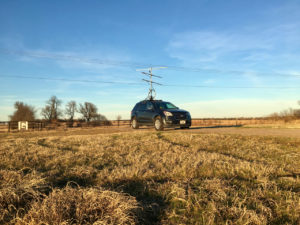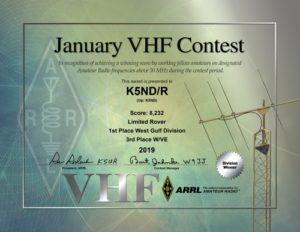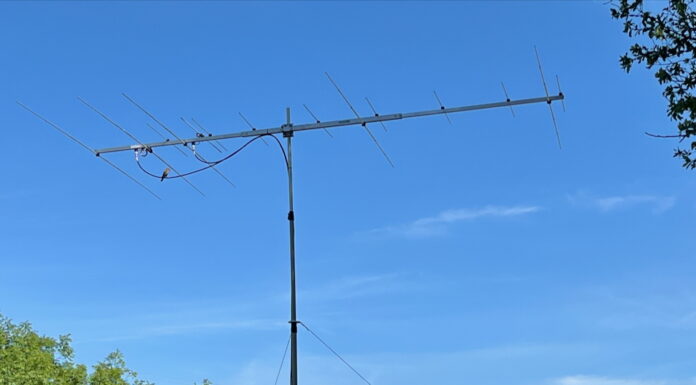Despite the cold and wind at the start of the contest, my rover operation turned out great. Highlights were a number of Es openings on 6 meters, several meteor scatter contacts, along with a face-to-face meeting with fellow rovers Kyle, KA5D/R, and Tim, KD5IKG/R, which led to my first experience with rovers circling grids to generate contacts and multipliers.
Grid Route
My grid route played out pretty much as I planned it. Although I did drop EM14 as the last stop. By that time, it was very dark and I was quite tired. I also made two adjustments on the fly. After running into Kyle and Tim, I stopped as soon as I crossed the EM01/EM02 line and worked them in various other grids. As a result, I dropped my EM02 stop at Lake Mineral Wells. I also found a much better spot in EM24, high up with lots of visibility to the horizon.
Digital Modes
It was pretty amazing to find six meters in such good form in January. I’m pretty sure that FT8 made all that possible. Early in the contest on Saturday I didn’t see anything. That’s when Tim and Kyle made all the difference in my log. Late that night, when I was in EM03, I worked a number of stations to the west as well as MSK144 meteor scatter contacts with three stations in the upper Midwest. Not bad for about 80 watts and a stressed Moxon.
Sunday, I found six meter FT8 openings into the Gulf Coast when I was in EM12 and EM21. Then is was Texas and one or two Midwest stations from EM23. From EM24 it was primarily south into Mexico on FT8 along with a few MSK144 meteor scatter contacts to the upper Midwest.
Equipment
This was the first time I used my roof-top rotator/mast mount. I’ll write up a more comprensive post with the full details. The operating position inside the car made this rover trip possible. Standing outside in 30 degree temperatures and trying to guy a push-up mast in the heavy Saturday winds would not have worked at all.
Of course, the other advantage was that setup in each location was non-existent. That sure made a difference in where I could stop and work some contacts. I need to better take that into account during the next contest.
I also gained some insight from Kyle and Tim when we compared notes on our stations. I like their use of amplifiers to get up to the category power limit. They also had some good ways to get on 222 MHz, which is a next step for me.
I did experience a balun failure on the 6 meter moxon, but I had a loop of coax available for replacement. Coax routing needs more attention from me for the next effort.
Results
My preliminary score came in at 9,300 with 133 QSOs and 60 multipliers. QSOs came in at 58 in FT8, 7 in MSK144, all on 6 meters. SSB contacts were at 68. Six meters had 81 QSOs and 34 grids worked. Two meters had 30 QSOs and 8 grids. Seventy centimeters had 22 QSOs and 8 grids. I gained a few compliments on my 70 cm signal from the new DSE Rover Yagi.
Thanks to everyone that provided contacts and grids. I also appreciate the guys that put up with my puny stations for meteor scatter contacts — some successful, some not.
I also greatly appreciate Tim and Kyle for the inspiring time comparing notes on our rover operations as well as all the contacts and grids.
June 2019 — I see from the results just posted that I finished in 1st place West Gulf Division and 3rd place W/VE in the Limited Rover category.

